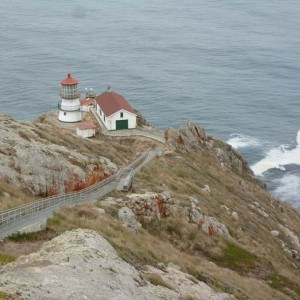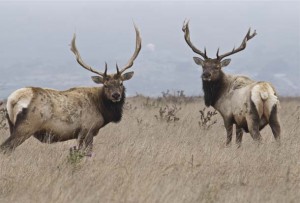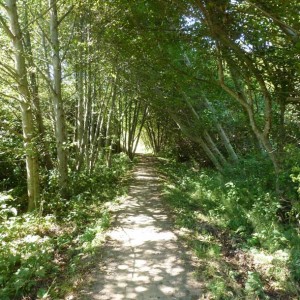This is part of a year-long effort to hike every trail at Point Reyes National Seashore, which turned 50 in 2012. Learn more. See a version of this hike mapped on our Trailfinder.
Limantour Beach to Five Brooks Pond, September 20, 2012. Clear, calm, and warm; idyllic. Check out this hike on our Trailfinder.
Few coastlines are as pacifying as the broad sandy beach at Limantour. The stalwart swells of the California current, deflected by the headlands of the outer point, generate a sweeping countercurrent that calms the waters of Drakes Bay and deposits fine, white sands along its shoreline. Walking the beach between the Limantour entrance and Coast Camp, the constant pulse of the waves provide a rhythmic mojo, lulling the casual rambler into a subconscious tranquility hard to come by in the hubbub of the other world. In its sparse, minimalist design, this landscape seems almost abstract. But each visit provides a unique experience. This morning there are dozens of Heermann’s gulls scattered along the shoreline. These unusually spiffy gulls breed in Mexico and each fall perform an unusual “reverse,” northward migration. Once they arrive along our coast they tend to follow brown pelicans (another “reverse” migrant), stealing food from the big birds as they plunge dive for herring and other small schooling fish. (Often the gull grabs the fish directly from the pelican’s bill!) But this morning there are few pelicans in sight and these gulls are behaving differently. Instead of pirating, the gulls are strewn along the shoreline, foraging in the backwash of the waves, probably for mole crabs, the most abundant invertebrate in the wave-washed sand.

The beach was relatively clean this morning, washed by a recent high tide, but there were numerous clawless carapaces of rather small Dungeness crabs cast along the morning’s upper tideline.

Dungeness crabs come into shallow inshore waters to molt the exoskeleton. This chitinous armor “presents a formidable barrier to love-making” and when the female is ready to molt, the larger male embraces her and she “nibbles at her partner’s eyestalks.” He then casts-off her old shell before copulation. As described in the deadpan prose of Between Pacific Tides: “. . .at the right moment, the female allows herself to be turned over to the proper position and extends her abdominal flap to receive the male, who inserts his gonopods into her spermathecae.” Who knew crabs assumed the missionary position?
A large Eucalyptus marks arrival at Coast Camp. A perennial creek feeds a small freshwater marsh where it empties onto the beach. Yellowthroats, marsh wrens, and song sparrows are chattering in the sedges here, and it’s a fine place to watch butterflies “puddling” in the moist sand. The purpose of puddling is not well understood, but according to Shapiro and Manolis’ excellent butterfly book (http://www.ucpress.edu/book.php?isbn=9780520249578), the males may be collecting dissolved minerals that are important for reproduction.

From Coast Camp south, the trail traverses northern coastal scrub, a rather dry and uniform habitat except where small coastal creeks cross the trail or rocky formations sprout from the substrate.
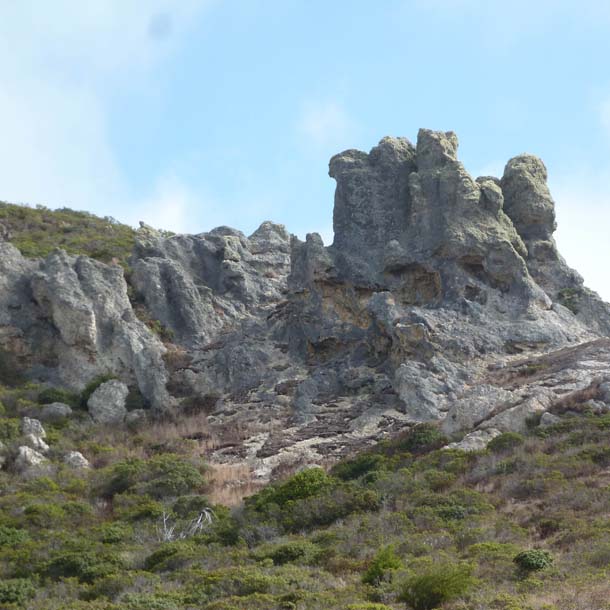
On this warm morning, two animal species are particularly common along the trail. Small skipper butterflies (hesperids) flush from the path with every few steps I take, and tiny lizards, apparently newly hatched, whisk across the trail, usually disappearing into the bordering vegetation.


Kelham Beach is reached by a short spur, but many steps down the coastal bluff just before arriving at Arch Rock. Even after more that 100 days without rain, a small waterfall is flowing down the cliff face onto the cobbled upper beach. The exposed geology in the coastal bluff here is remarkable—contorted, rhythmic waves of sediment telling the story of the peninsula’s tumultuous and tortuous journey up the California coast.
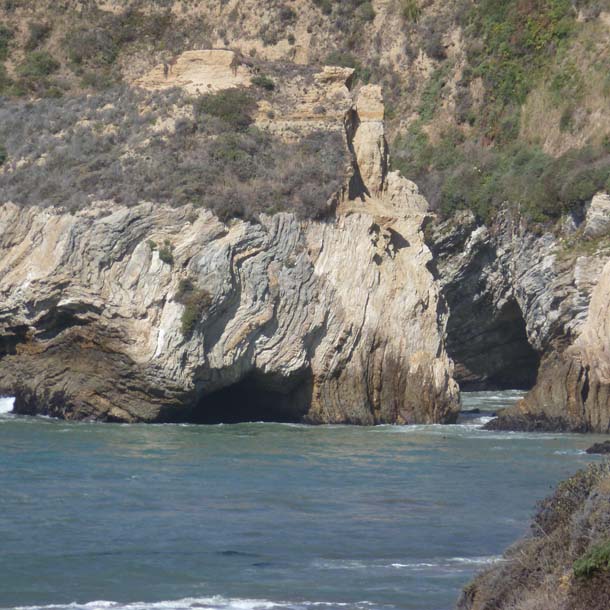
After paralleling the coastline from Coast Camp to Arch Rock, the Coast Trail. Photograph by Jules Evens
Beyond Arch Rock, Coast Trail veers upslope and climbs toward the fir forest that begins to overtake the coastal scrub at higher elevations. The fir-forest is fed by increased moisture produced by advection fog that forms as the elevation increases.
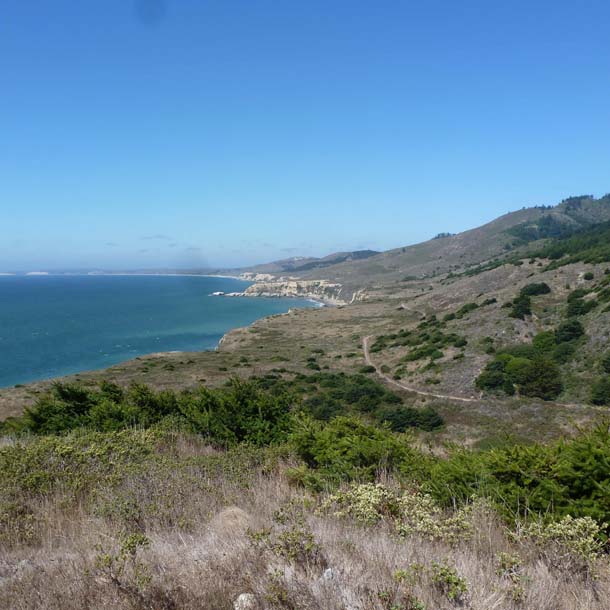
It’s warm now. As I trudge up the trail I notice a large animal scoot out from under the shade of a tree and stop in the trail to stare back at me. We assess each other for a few seconds, and with a dismissive shake of his coat, he trots off up the trail ahead of me, leading the way. This is coyote— trickster, western demigod—whose presence provides a certain reassurance that everything is in order. This sense of order is more than mystical. Coyote is an apex predator and his presence ensures that populations of subordinate “mesopredators”—skunks, raccoons, foxes, feral cats—are kept in check. Due to this predator balance, in fragmented landscapes (aren’t they all?) when coyotes are present, prey species such as shrub nesting birds—quail, towhees, sparrows, wrens and wrentits—are more abundant than they are in landscapes where coyotes are absent. This ecological model was elegantly demonstrated in a southern California study by Kevin Crooks and Michael Soule entitled “Mesopredator release and avifaunal extinctions in a fragmented system” (Nature Vol. 400, pp 563-565).
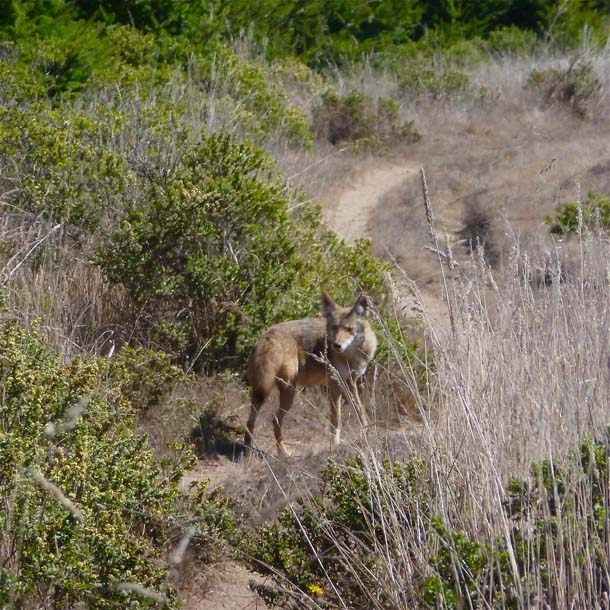
After intersecting with Glen Trail and the Stewart Trail and climbing the last few miles to the ridge, it is a gentle four mile stroll down the eastern flank of Inverness Ridge to Five-Brooks. It’s getting late in the day, and the coolness of an autumn evening in the shade of the conifers is a welcome respite from the swelter of the long day’s journey. The chorus of the deep forest is beginning to cue up. A Townsend’s Chipmunk chatters from the understory; a Pileated Woodpecker cackles in the distance. Red-breasted Nuthatches “yank yank” from the upper boughs of the firs and a tight flock of Red Crossbills flies overhead, newly arrived refugees from a cone crop failures far to the north. I expect to hear the mellow hoots of a Northern Spotted Owl that has lived in this canyon as long as I can remember . . . He is silent this evening, but I know he’s here, and that’s enough.

Trail notes. This 14-mile trek from Limantour Beach to Five-Brooks follows the coast past Bear Valley Creek then climbs through coastal scrub into Douglas-fir forest, crests at Fir Top, then follows the Stewart Trail for four miles downhill along the east slope of Inverness Ridge. This route is a long trek and it requires a full day to enjoy fully. In September, weather can vary from fog in the morning, to blistering mid-day sun, to wind in the afternoon, to cool evenings. Take plenty of water, sunscreen, a hat, and layers of clothing. The climb from the coast upslope is fairly arduous, especially after having walked 6 miles before getting to the steep part. Best to leave from Limantour rather than the reverse, because the afternoon wind can be intense, and you probably don’t want to walk into a headwind for the last few miles.
Acknowledgements: The sex life of the Dungeness crab was quoted from the 5th edition of Between Pacific Tides, Stanford University Press (1985). Art Shapiro, Rich Stallcup, and Bob Stewart provided much-needed help with butterfly identification.


